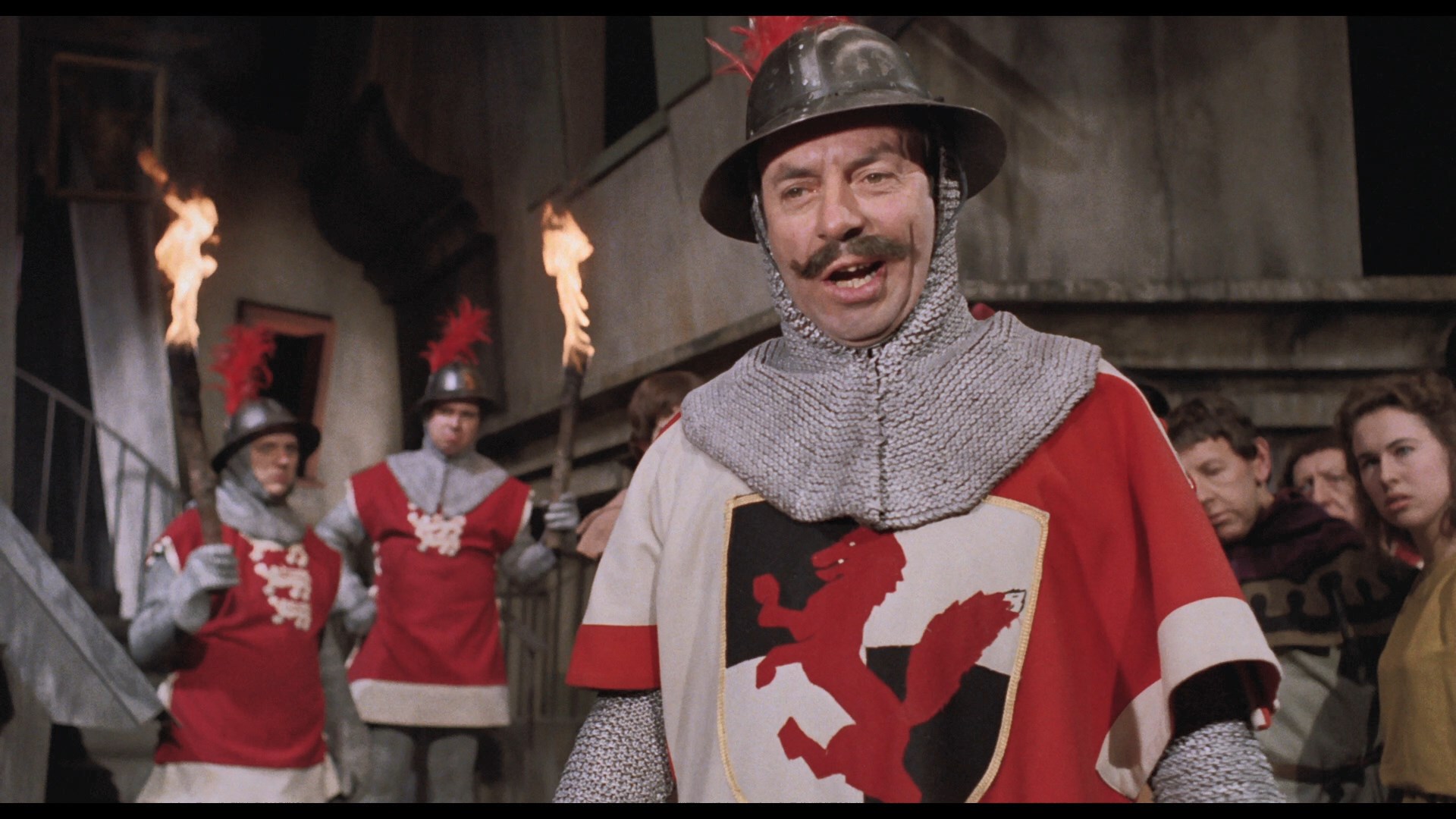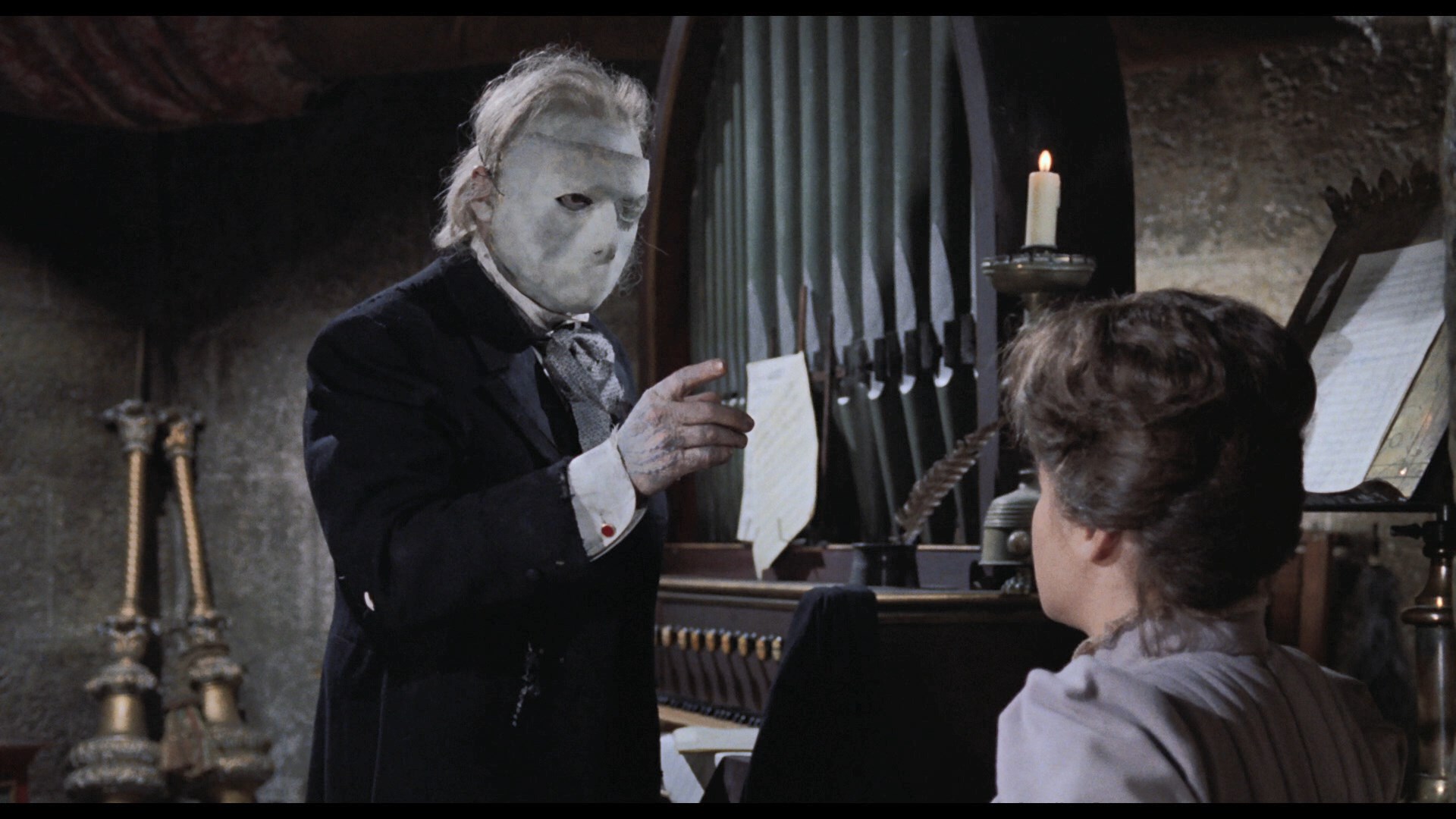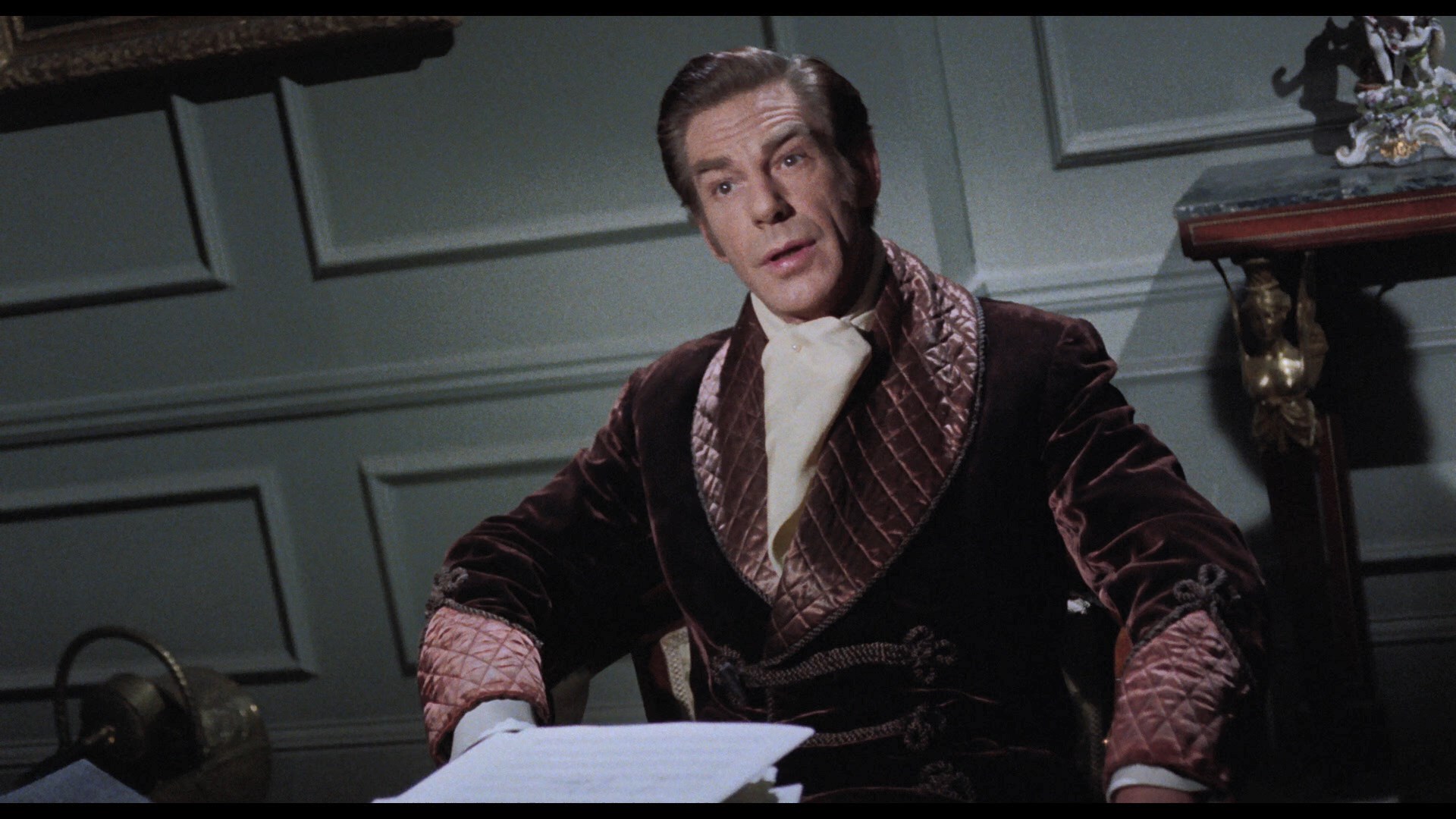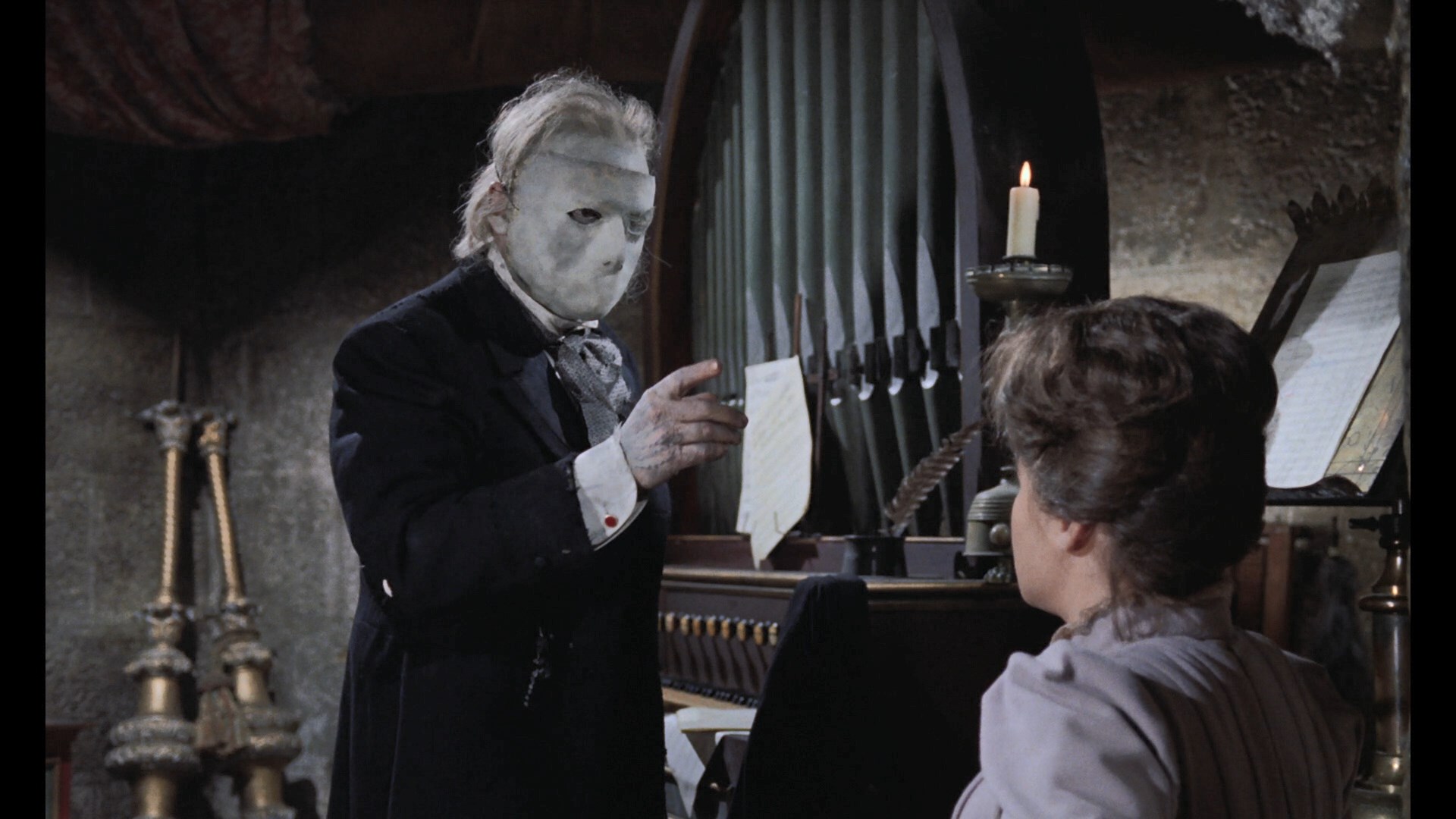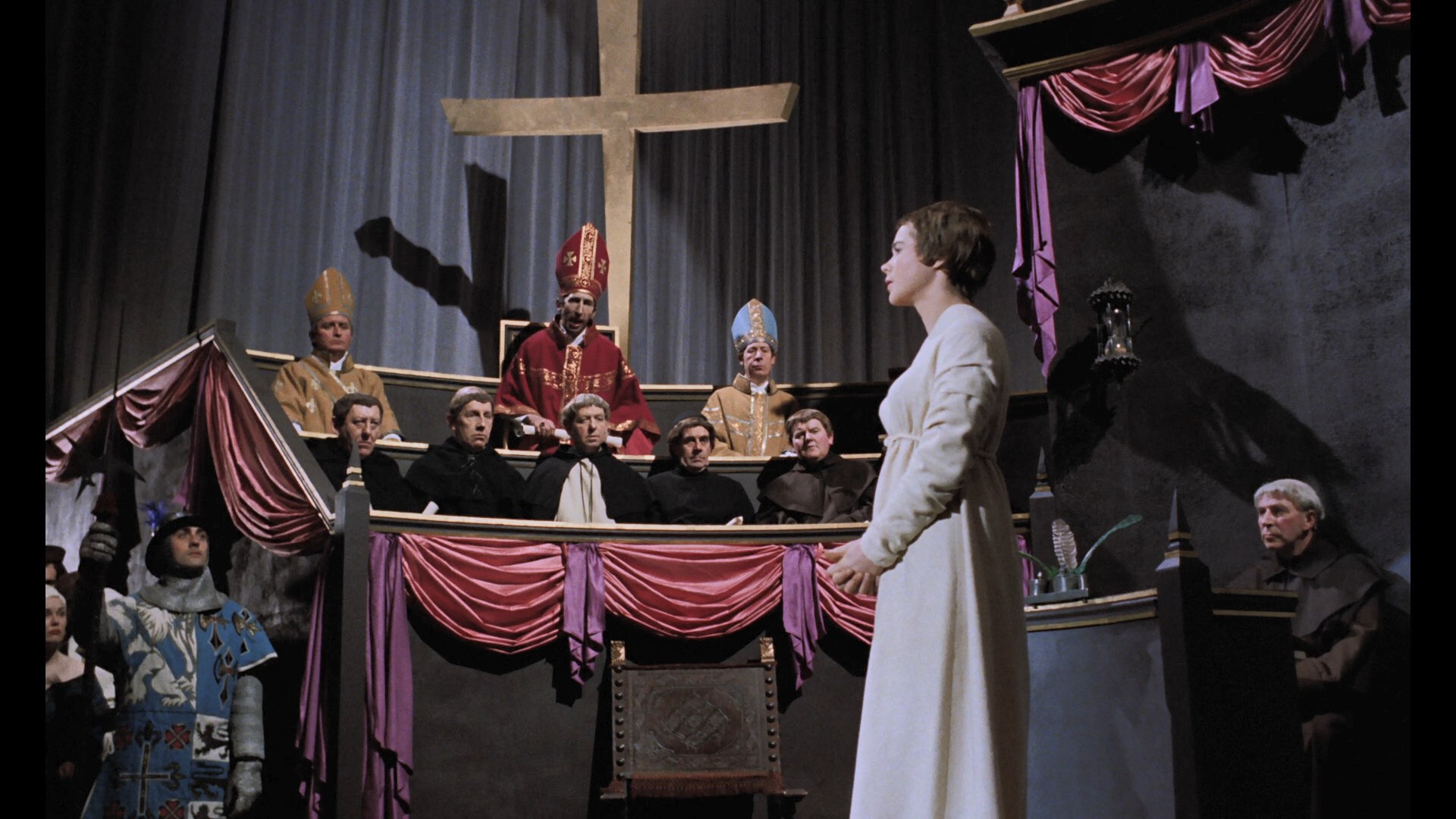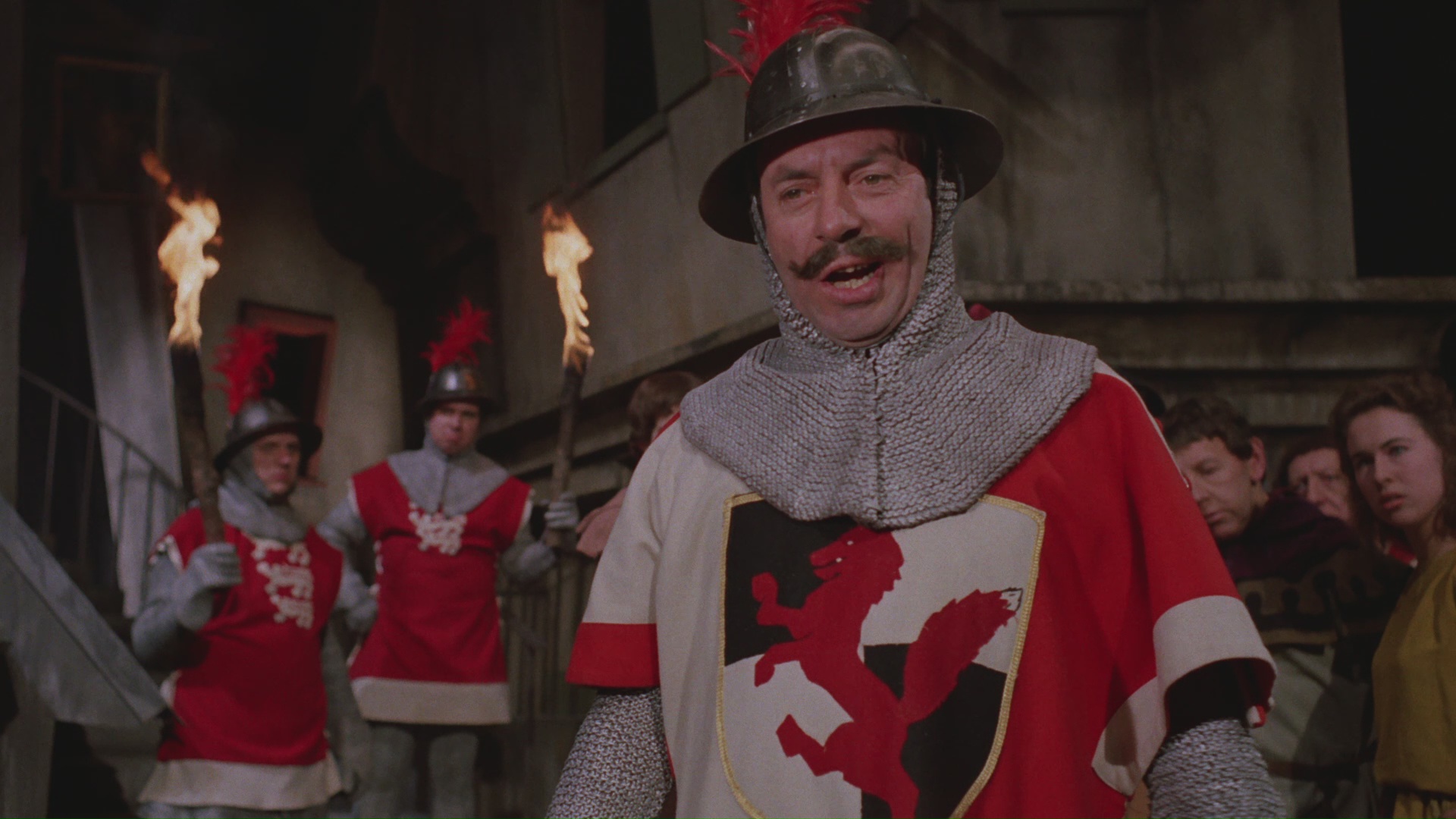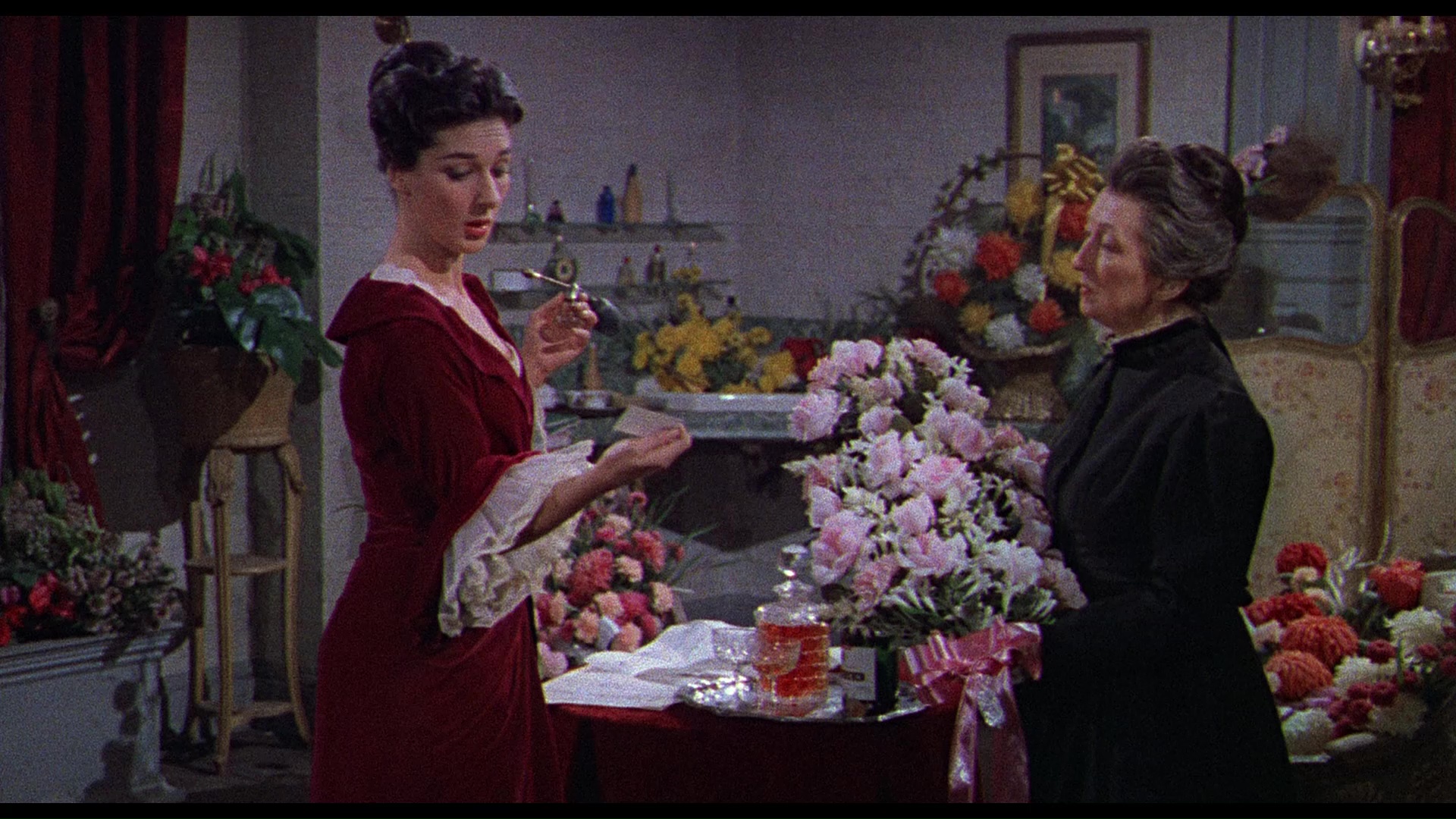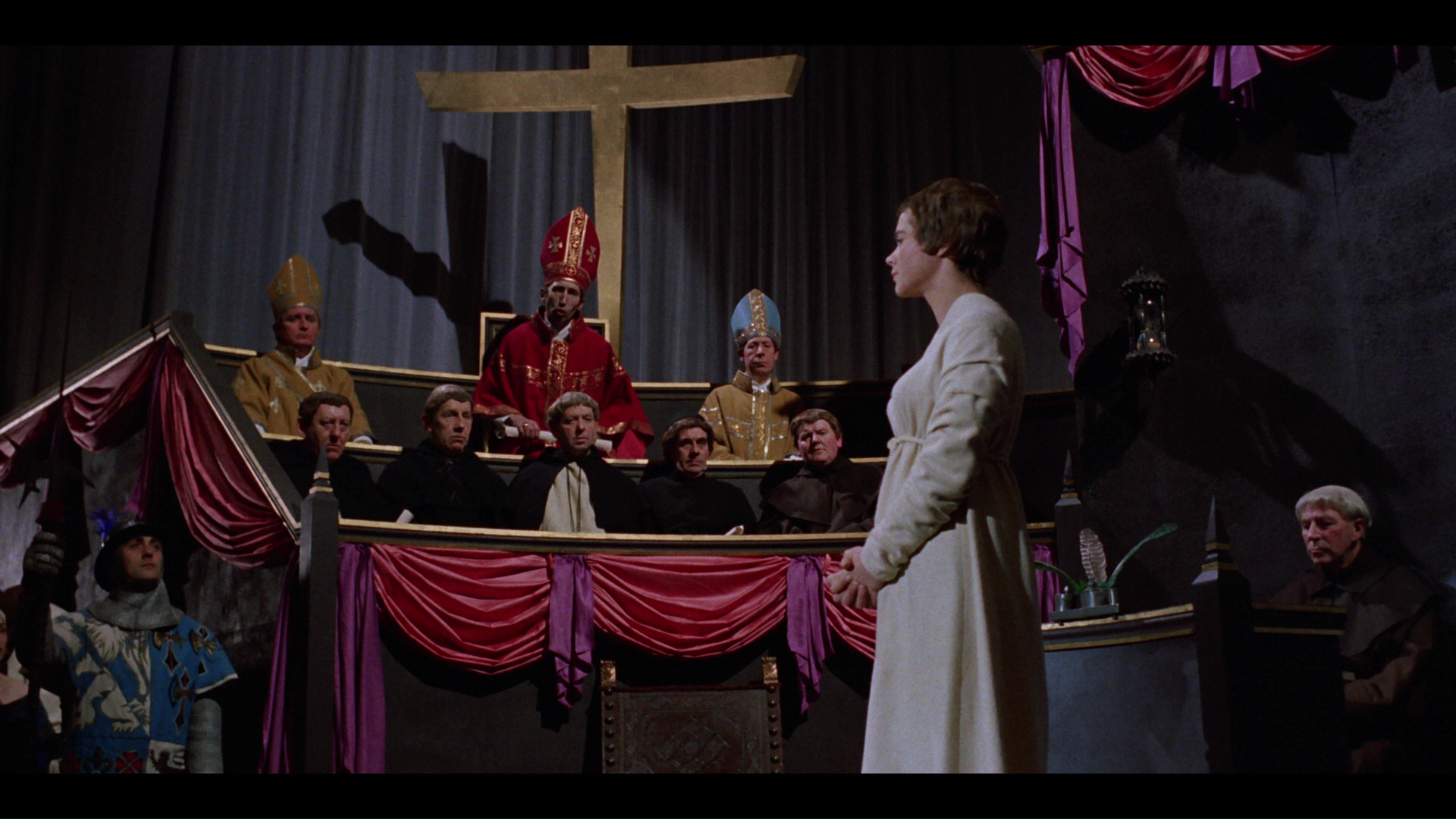

THE SHADOW OF THE CAT
B&W, 1961, 78 mins. 42 sec.
Directed by John Gilling
Starring André Morell, Barbara Shelley, William Lucas, Freda Jackson, Conrad Phillips, Catherine Lacey
Indicator (Blu-ray) (UK RB HD), Scream Factory (Blu-ray) (US RA HD) / WS (1.66:1) (16:9), Final Cut (DVD) (UK R2 PAL)
CAPTAIN CLEGG (NIGHT CREATURES)
Color, 1962, 82 mins. 7 secs.
Directed by Peter Graham Scott
Starring Peter Cushing, Yvonne Romain, Oliver Reed, Patrick Allen, Michael Ripper, Martin Benson
Indicator (Blu-ray) (UK RB HD) / WS (1.85:1) (16:9), Anolis (Blu-ray) (Germany RB HD) / WS (1.78:1) (16:9), Universal (Blu-ray & DVD) (US R0 HD/NTSC), Final Cut (Blu-ray & DVD) (UK RB/R2 HD/PAL) / WS (2.00:1) (16:9)
THE PHANTOM OF THE OPERA
Color, 1962, 84 mins. 12 secs.
Directed by Terence Fisher
Starring Herbert Lom, Heather Sears, Edward de Souza,
Michael Gough, Thorley Walters, Patrick Troughton, Ian Wilson
Indicator (Blu-ray) (UK RB HD), Scream Factory (Blu-ray) (US RA HD) / WS (1.85:1, 1.66:1) (16:9), Anolis (Blu-ray) (Germany RB HD) / WS (1.78:1) (16:9), Universal (Blu-ray & DVD) (US R0 HD/NTSC) / WS (2.00:1) (16:9), Final Cut (Blu-ray & DVD) (UK RB/R2 HD/PAL) / WS (1.85:1) (16:9)
NIGHTMARE
B&W, 1964, 82 mins. 20 secs.
Directed by Freddie Francis
Starring David Knight, Moira Redmond, Jennie Linden, Brenda Bruce, George A. Cooper, Clytie Jessop
Indicator (Blu-ray) (UK RB HD), Universal (Blu-ray & DVD) (US R0 HD/NTSC), Final Cut (Blu-ray & DVD) (UK RB/R2 HD/PAL) / WS (2.35:1) (16:9)
 anywhere on it. Shot at Bray Studios with a cast of familiar faces including Hammer vets André Morell
anywhere on it. Shot at Bray Studios with a cast of familiar faces including Hammer vets André Morell  (The Hound of the Baskervilles) and Barbara Shelley (Dracula, Prince of Darkness), it's a highly entertaining body count film as well as a key installment in the strain of genre films that try to paint cats as frightening even though they're actually being heroic. (See also, Eye of the Cat and The Uncanny.) This one was on people's wish lists for a long time, steadfastly refusing to turn up on home video in any form until a mediocre 2014 British DVD from Final Cut Entertainment (cropped on the sides to 1.33:1) with word circulating that existing elements would make a Blu-ray release highly unlikely. (At least that release featured a nice stills gallery, a trailer, a worthwhile "Shadow Play: Inside The Shadow of the Cat" 25m37s featurette with Alan Barnes, Marcus Hearn, Denis Merle, Jason Morell, and Jonathan Rigby, and a "Catastrophy" 3m49s audio interview with special effects assistant Ian Scoones.) That means the first Blu-ray edition out of the gate in 2020 from Scream Factory (as part of its Universal Horror Collection Volume Six set) was a pretty big deal, finally showing the film off in pristine condition in its intended 1.66:1 aspect ratio and allowing us to really appreciate its beautiful Gothic visuals for the first time in decades. It took another year, but the U.K. Blu-ray debut from Indicator equals it and sweetens the deal with some extra goodies of its own.
(The Hound of the Baskervilles) and Barbara Shelley (Dracula, Prince of Darkness), it's a highly entertaining body count film as well as a key installment in the strain of genre films that try to paint cats as frightening even though they're actually being heroic. (See also, Eye of the Cat and The Uncanny.) This one was on people's wish lists for a long time, steadfastly refusing to turn up on home video in any form until a mediocre 2014 British DVD from Final Cut Entertainment (cropped on the sides to 1.33:1) with word circulating that existing elements would make a Blu-ray release highly unlikely. (At least that release featured a nice stills gallery, a trailer, a worthwhile "Shadow Play: Inside The Shadow of the Cat" 25m37s featurette with Alan Barnes, Marcus Hearn, Denis Merle, Jason Morell, and Jonathan Rigby, and a "Catastrophy" 3m49s audio interview with special effects assistant Ian Scoones.) That means the first Blu-ray edition out of the gate in 2020 from Scream Factory (as part of its Universal Horror Collection Volume Six set) was a pretty big deal, finally showing the film off in pristine condition in its intended 1.66:1 aspect ratio and allowing us to really appreciate its beautiful Gothic visuals for the first time in decades. It took another year, but the U.K. Blu-ray debut from Indicator equals it and sweetens the deal with some extra goodies of its own. persistent presence drives the criminals to increasingly desperate and ultimately fatal
persistent presence drives the criminals to increasingly desperate and ultimately fatal  behavior.
behavior.  pristine and comes with improved English SDH subtitles. The Hallenbeck commentary, TV spot, and
pristine and comes with improved English SDH subtitles. The Hallenbeck commentary, TV spot, and  Shelley interview are both ported over here, plus the earlier "Shadow Play" documentary from the DVD. Kim Newman provides a fun new video intro (10m37s) about the film's odd place in the Hammer pantheon, the aborted project it sprang from, and Gilling's traits as a filmmaker, while "Cat People" (4m34s) has memories from assistant costume designer Yvonne Blake and the property department's Peter Allchorne about some of the more challenging aspects of the production, including Gilling's strict nature as a boss. Allchorne remembers a lot more than Blake, but both are certainly welcome here. (It can't be said enough how valuable these retrospective pieces with below-the-line personnel are!) "Special FX Catastrophe" (3m58s) features a quick audio interview (from a windy phone connection) with assistant special effects artist Ian Scoones about his own tenure on the film and the advice he got about tripping over cables, while Jackson gets here due in a new installment of "Hammer's Women" (9m5s) with Lucy Bolton offering an informative and charming appraisal of the Nottingham-born actress' multiple Hammer contributions as well as her other work including Shakespearean theater. David Huckvale provides another of his terrific film score breakdowns in "Catmotifs" (17m21s) diving into the work of composer Mikis Theodorakis, plus his role in the Greek music scene, his politic, and his absolutely insane life story ("He was buried alive... twice"). The image gallery section is divided into production stills (23 of 'em) and promotional material (42 stills, lobby cards, posters, etc.). The disc also comes with a 36-page booklet featuring an essay by Craig Ian Mann, original press material highlights, an archival interview with Shelley, and sample critical reactions.
Shelley interview are both ported over here, plus the earlier "Shadow Play" documentary from the DVD. Kim Newman provides a fun new video intro (10m37s) about the film's odd place in the Hammer pantheon, the aborted project it sprang from, and Gilling's traits as a filmmaker, while "Cat People" (4m34s) has memories from assistant costume designer Yvonne Blake and the property department's Peter Allchorne about some of the more challenging aspects of the production, including Gilling's strict nature as a boss. Allchorne remembers a lot more than Blake, but both are certainly welcome here. (It can't be said enough how valuable these retrospective pieces with below-the-line personnel are!) "Special FX Catastrophe" (3m58s) features a quick audio interview (from a windy phone connection) with assistant special effects artist Ian Scoones about his own tenure on the film and the advice he got about tripping over cables, while Jackson gets here due in a new installment of "Hammer's Women" (9m5s) with Lucy Bolton offering an informative and charming appraisal of the Nottingham-born actress' multiple Hammer contributions as well as her other work including Shakespearean theater. David Huckvale provides another of his terrific film score breakdowns in "Catmotifs" (17m21s) diving into the work of composer Mikis Theodorakis, plus his role in the Greek music scene, his politic, and his absolutely insane life story ("He was buried alive... twice"). The image gallery section is divided into production stills (23 of 'em) and promotional material (42 stills, lobby cards, posters, etc.). The disc also comes with a 36-page booklet featuring an essay by Craig Ian Mann, original press material highlights, an archival interview with Shelley, and sample critical reactions. with the source novel and its title character, usually called Erik but deprived of a first name here. The film was also the splashiest entry in a string of Hammer titles for Universal, a prime period that also included such
with the source novel and its title character, usually called Erik but deprived of a first name here. The film was also the splashiest entry in a string of Hammer titles for Universal, a prime period that also included such  favorites as The Kiss of the Vampire, The Curse of the Werewolf, and Paranoiac, which meant it also went into TV circulation for decades where it left a stronger impression on younger horror fans.
favorites as The Kiss of the Vampire, The Curse of the Werewolf, and Paranoiac, which meant it also went into TV circulation for decades where it left a stronger impression on younger horror fans. color compositions, and far more pathos than you’d expect with Lom
color compositions, and far more pathos than you’d expect with Lom  as perhaps the most sympathetic and passive Phantom of them all. It's an odd switch that threw fans of the earlier versions as the real villain duties here go to Gough, who strangely doesn't really get the comeuppance you would normally expect. The perverse subversion of what audiences wanted turned out to be a problem of course; the usual elements are all here like the falling chandelier, the Phantom's organ playing in his cave (later parodied by Lom in the brilliant The Pink Panther Strikes Again), and the opera house managers grappling with the crisis. However, it's all been scrambled around a bit to create a markedly different story by the end with a climax that's quite different from any other version. It's still an extremely rich, fast-paced entertainment if you take it on its own terms, and it certainly deserves a more esteemed place in the Hammer rankings than it usually enjoys. Like two other Universal Hammer films (The Kiss of the Vampire and The Evil of Frankenstein), the film was heavily edited for television and padded out with new scenes showing Scotland Yard at work trying to unravel the mystery; however, this edition rarely turned up on the air after its initial appearance.
as perhaps the most sympathetic and passive Phantom of them all. It's an odd switch that threw fans of the earlier versions as the real villain duties here go to Gough, who strangely doesn't really get the comeuppance you would normally expect. The perverse subversion of what audiences wanted turned out to be a problem of course; the usual elements are all here like the falling chandelier, the Phantom's organ playing in his cave (later parodied by Lom in the brilliant The Pink Panther Strikes Again), and the opera house managers grappling with the crisis. However, it's all been scrambled around a bit to create a markedly different story by the end with a climax that's quite different from any other version. It's still an extremely rich, fast-paced entertainment if you take it on its own terms, and it certainly deserves a more esteemed place in the Hammer rankings than it usually enjoys. Like two other Universal Hammer films (The Kiss of the Vampire and The Evil of Frankenstein), the film was heavily edited for television and padded out with new scenes showing Scotland Yard at work trying to unravel the mystery; however, this edition rarely turned up on the air after its initial appearance.  film and its place in the history of Leroux adaptations. The first U.S. Blu-ray in that Universal set
film and its place in the history of Leroux adaptations. The first U.S. Blu-ray in that Universal set  sported a much improved 2.00:1 transfer that added quite a bit more to the sides compared to the Final Cut and featured vastly superior color rendition and detail. Last and even better was the 2017 German edition from Anolis, whose great track record with Hammer titles offers a 1.78:1 presentation with more visual information on all four sides than its predecessors. The color scheme and detail level look comparable to the Universal release, and the English mono track is presented in DTS-HD MA along with the German dub and a German-only audio commentary by Dr. Rolf Giesen and Uwe Sommerlad. The Final Cut documentary is ported over here, and the theatrical trailer is included in far more pristine quality than anywhere else. Also included is a sample of the German main titles (which are very different), some German-shot signs of opera posters throughout the film, and the closing credits; also on hand are an image gallery, a U.S. radio spot, and samples of international pressbooks in English, German and French.
sported a much improved 2.00:1 transfer that added quite a bit more to the sides compared to the Final Cut and featured vastly superior color rendition and detail. Last and even better was the 2017 German edition from Anolis, whose great track record with Hammer titles offers a 1.78:1 presentation with more visual information on all four sides than its predecessors. The color scheme and detail level look comparable to the Universal release, and the English mono track is presented in DTS-HD MA along with the German dub and a German-only audio commentary by Dr. Rolf Giesen and Uwe Sommerlad. The Final Cut documentary is ported over here, and the theatrical trailer is included in far more pristine quality than anywhere else. Also included is a sample of the German main titles (which are very different), some German-shot signs of opera posters throughout the film, and the closing credits; also on hand are an image gallery, a U.S. radio spot, and samples of international pressbooks in English, German and French. Sangster to crank out numerous twisty psycho-shockers, almost all monochrome, including Maniac, Hysteria, and The Nanny,
Sangster to crank out numerous twisty psycho-shockers, almost all monochrome, including Maniac, Hysteria, and The Nanny,  with stragglers Crescendo and Fear in the Night coming along in the '70s. Even a cursory viewing would make it obvious that most of these were far more indebted to Diabolique than Psycho, and that's certainly the case here as well with one of the most beautifully shot films from the cycle.
with stragglers Crescendo and Fear in the Night coming along in the '70s. Even a cursory viewing would make it obvious that most of these were far more indebted to Diabolique than Psycho, and that's certainly the case here as well with one of the most beautifully shot films from the cycle.  photography here, John Wilcox, is the most valuable player here by far, using
photography here, John Wilcox, is the most valuable player here by far, using  expansive CinemaScope framing to perform beautiful visual tricks with light, shadow, and depth of field in every single shot. It's a real feast for the eyes, even more than Francis' scariest entry in the cycle, Paranoiac. The story itself hinges on not one but two schemes that couldn't possibly work at all in practice, even by the standards of these films; if you don't mind throwing any allegiance to plausibility out the window though, it's an entertaining and deliciously overheated rollercoaster of a thriller with enough narrative switchbacks to keep you on your toes.
expansive CinemaScope framing to perform beautiful visual tricks with light, shadow, and depth of field in every single shot. It's a real feast for the eyes, even more than Francis' scariest entry in the cycle, Paranoiac. The story itself hinges on not one but two schemes that couldn't possibly work at all in practice, even by the standards of these films; if you don't mind throwing any allegiance to plausibility out the window though, it's an entertaining and deliciously overheated rollercoaster of a thriller with enough narrative switchbacks to keep you on your toes.  by Kevin Lyons and Jonathan Rigby is as good as you'd expect, rattling through the cast and crew, addressing the questionable claim that Julie Christie was originally cast as
by Kevin Lyons and Jonathan Rigby is as good as you'd expect, rattling through the cast and crew, addressing the questionable claim that Julie Christie was originally cast as  Janet, examining the famous but also somewhat dubious working title of Here's the Knife, Dear - Now Use It, and sharing lots of anecdotes about the participants including some great info about Jessop. Also playable over the film is 1994's The BEHP Interview with Freddie Francis, which runs over the length of the feature with the filmmaking chatting with Alan Lawson and Syd Wilson about his career as both a director and cinematographer, the difficulty of "being a director and a gentleman," the lessons he learned about how to man a cinematic ship, and his candid thoughts about the wide variety of films over the course of his career. In the last "Hammer's Women" (10m2s), Pamela Hutchinson presents a thorough biography of Redmond, who enjoyed a productive career on both the small and large screens as well as on the stage where her flaming auburn hair became something of her signature. A video intro by Kim Newman (8m10s) is largely focused on Sangster, not surprisingly, including his wholesale recycling of the plot in 1971's A Taste of Evil, the impact of Jessop's performance, and the various genre connections strewn throughout. Huckvale tackles another score here in "Something Lurking in the Chords" (29m48s), this time going back to Banks again for a study of how the psychology and suspense of the film are accentuated by the string-heavy musical approach here. Three extras are also ported over from the film's earlier U.K. Blu-ray release in 2016 from Final Cut, starting with a "Memories" video interview with Linden (14m15s). She warmly recounts her experiences in and out of the movie industry including the family break she was on that she had to break to work with Ken Russell, her own son's affinity for acting, and her thoughts on the productions she worked on throughout her life. In "Madhouse: Inside Hammer's Nightmare" (14m12s), Rigby and Lyons are joined by Hammer historians Alan Barnes and John J Johnston for an overview of the production including James Carreras' role in shepherding it to the screen and the roles of both Francis and Sangster within the studio at the time. Finally, "Nightmare in the Making" (27m14s) offers another take on the making of the film with Wayne Kinsey threading the film's history through interview footage with Linden, Sangster, and art director Don Mingaye (not to mention some great still photos from this and other connected Hammer films). Finally you get the very dramatic theatrical trailer (here taken from the usual full frame SD master we've had for ages) and galleries for production stills (43 images) and promotional material (42 images). This time the insert booklet has an essay by Emma Westwood, press material samples, and critical reactions.
Janet, examining the famous but also somewhat dubious working title of Here's the Knife, Dear - Now Use It, and sharing lots of anecdotes about the participants including some great info about Jessop. Also playable over the film is 1994's The BEHP Interview with Freddie Francis, which runs over the length of the feature with the filmmaking chatting with Alan Lawson and Syd Wilson about his career as both a director and cinematographer, the difficulty of "being a director and a gentleman," the lessons he learned about how to man a cinematic ship, and his candid thoughts about the wide variety of films over the course of his career. In the last "Hammer's Women" (10m2s), Pamela Hutchinson presents a thorough biography of Redmond, who enjoyed a productive career on both the small and large screens as well as on the stage where her flaming auburn hair became something of her signature. A video intro by Kim Newman (8m10s) is largely focused on Sangster, not surprisingly, including his wholesale recycling of the plot in 1971's A Taste of Evil, the impact of Jessop's performance, and the various genre connections strewn throughout. Huckvale tackles another score here in "Something Lurking in the Chords" (29m48s), this time going back to Banks again for a study of how the psychology and suspense of the film are accentuated by the string-heavy musical approach here. Three extras are also ported over from the film's earlier U.K. Blu-ray release in 2016 from Final Cut, starting with a "Memories" video interview with Linden (14m15s). She warmly recounts her experiences in and out of the movie industry including the family break she was on that she had to break to work with Ken Russell, her own son's affinity for acting, and her thoughts on the productions she worked on throughout her life. In "Madhouse: Inside Hammer's Nightmare" (14m12s), Rigby and Lyons are joined by Hammer historians Alan Barnes and John J Johnston for an overview of the production including James Carreras' role in shepherding it to the screen and the roles of both Francis and Sangster within the studio at the time. Finally, "Nightmare in the Making" (27m14s) offers another take on the making of the film with Wayne Kinsey threading the film's history through interview footage with Linden, Sangster, and art director Don Mingaye (not to mention some great still photos from this and other connected Hammer films). Finally you get the very dramatic theatrical trailer (here taken from the usual full frame SD master we've had for ages) and galleries for production stills (43 images) and promotional material (42 images). This time the insert booklet has an essay by Emma Westwood, press material samples, and critical reactions.




















